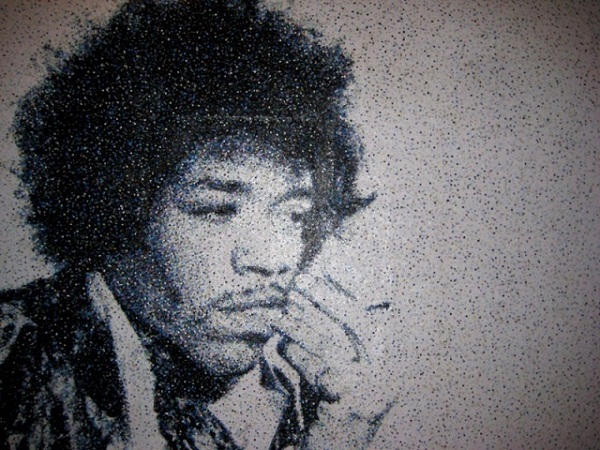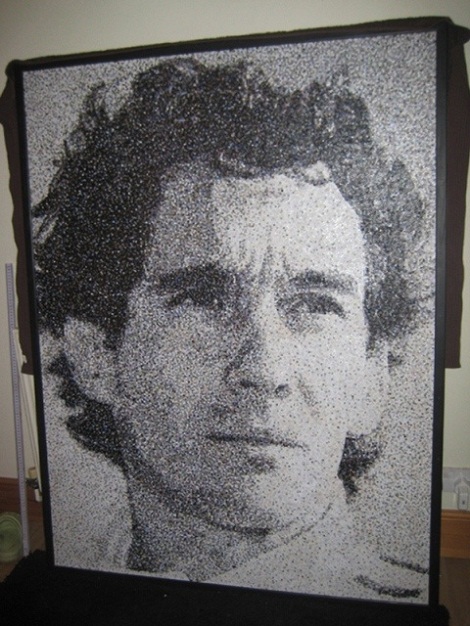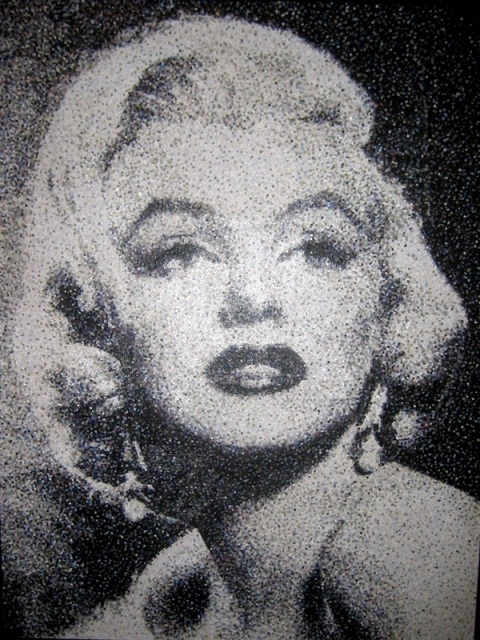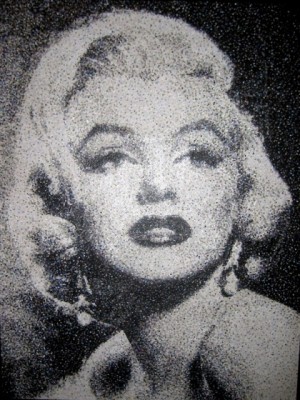Artist of the Week 10/24-10/30: Nikki Douthwaite Makes Art in the Fast Lane – Dots and All
GALO: Is there a favorite piece you’ve done? And, consequently, is there a piece that has been the hardest? Furthermore, has doing dot art become “easier” over time, such as with recent works including James Hunt, or does each piece present its own unique challenges?
ND: There are definitely pieces I have enjoyed more than others. Anything with teeth or curly hair or glasses I find challenging, and [it is] not always fun trying to get them right. Unpicking dots is not fun. I really enjoyed making Marilyn (Marilyn Monroe, December 2010) because most of my other portraits have been men, and I have enjoyed making the ones that mean something to me like Jenson Button (May 2011) and James Hunt (August 2012). The hardest one so far was Senna (Ayrton Senna, August 2010), because it was the first one I made for McLaren that was out of colored dots, but looked black and white from a distance. If I am honest, it annoys me that I could have done it better now that I have had more practice.
GALO: Your artist statement mentions you work for 10-14 hours at a time. About how long overall does it usually take to create a work? What type of environment do you prefer to work in?
ND: It depends on how big the picture is. They have taken me between five weeks and three months. I like to work at home, usually through the night so that I don’t get disturbed, listening to box sets of TV programs. I can’t tell you how many times I have watched/listened to all of Grey’s Anatomy, Bones, Friends, Criminal Minds, House, Weeds and many, many more. They need to make me more TV! I sit on the floor [while I work] and my faithful friend Maggie (my dog) curls up next to me. I am basically a living cliché: artist, lives alone, has OCD and insomnia, and has a dog, bit of a hermit.

“Jimi Hendrix,” made with about 150,000 dots on wood by Nikki Douthwaite. 150cm by 200cm, completed January 2012, sold to a Private Collector. Photo Courtesy of: Nikki Douthwaite.
GALO: When creating a motorsports piece, such as Sebastian Vettel (September 2010), what type of reference material do you use? Do you recreate the “look” of a person you see from an outside source, or do you imagine the facial expression and then bring it to life?
ND: When I make a current driver, because I watch so much F1, I know their personalities and as I have become less worried about the process and more about the picture, I like to pause the TV and draw them from that, with an expression that I think captures how I see them. I am currently making a Vettel in dots, and for this one, rather than the collage, I know more about Sebastian, and have now met him. So getting his character is more important to me.
With past drivers, McLaren has sent me pictures to draw from, so I choose one that captures how I remember them when they raced, like James Hunt, Fittipaldi and Lauda (not yet released pictures) and my all-time favorite driver I have left until last because I wanted one to be excited about at the end: Mika Hӓkkinen.

Ayrton Senna made with about 99,000 dots on wood. 158cm by 122cm. Completed March 2011. Photo Courtesy of: Nikki Douthwaite.
GALO: Your works In Seine (June 2008) and Lewis Hamilton (November 2008) feature vibrant colors, whereas other works, such as Muhammad Ali (March 2012), contain many grays and sepia tones. How is the color effect achieved, especially in the case of Lewis Hamilton?
ND: The change came about because of visiting McLaren and [him] wanting me to make pictures look black and white from a distance but out of colored dots, as that is what suits the McLaren Technology Centre, so I had to make another Lewis to match the others (also not seen yet). To be honest, I don’t know how I do it. I just make mixtures of hundreds of colored dots in tone batches and I know if the balance is off before I even stick them. I’ll say “that needs more purple” and my friends look at me like “there are 10,000 dots mixed up there, how do you know it needs more purple?” I just do.
GALO: With the exception of In Seine, all of the works shown on your Web site are on wood. Why wood as a medium versus canvas or mixed media? Have you considered using other mediums before or using different tools to create your dots?
ND: I have lots of ideas I want to play with in the future, but the journey so far has just been about getting these F1 pictures done, and making whatever else I had to make to allow me to sit and make these. I switched from canvas to wood after the first picture as canvas did not offer a firm enough background; wood works far better to press dots against. I figured this out partway through the first picture, but it was too late to do anything about that one as I had a deadline: my degree show! I am always assessing and trying to improve my technique.

Marilyn Monroe made with about 99,000 dots on wood. 160cm by 122cm. Completed December 2010. Photo Courtesy of: Nikki Douthwaite.
GALO: You mention in the Artist Statement on your website the two distinct experiences you hope viewers of your work get, the up close experience of either thousands of tiny, mixed up colored dots, or readable magazine articles, and the view from a distance where the viewers’ eyes and brain mix the dots/articles/colors together. But what do you hope society as a whole, rather than the individual, gets? How do you or your work want to be remembered?
ND: I am under no illusions that my work will affect society as a whole, apart from maybe people thinking, “Look what you can achieve with dedication and hard work.” I make my work for myself as an outlet, and if people enjoy it, then that is a bonus. I like to hide around a corner and watch people look at my work, and watch them walking back and forth, and then when they get close up their mouths drop open, like “someone sat and stuck all these, are they crazy?” Yes a little bit! That makes me smile.
I’d like to be remembered as the crazy dot lady, who just spent her life, quietly and happily sticking dots to make breathtaking pictures, someone who turned her love for color, OCD, hard work and insomnia into a positive thing.
GALO: What do you see as the next step in your career — a continuation of the motorsports theme or a different focus?
ND: I have so many ideas for the future. Next I would like to make both portraits from other media (like my F1 Magazine article, ones where you can read the careers [of the people shown] in the faces) and then take the dots away from portraits and use them for other pictures. However, I can see [myself] doing one or two dot portraits a year, so eventually I have a full collection of all the F1 champions that one day get collected up and displayed all together, probably when I am dead!


